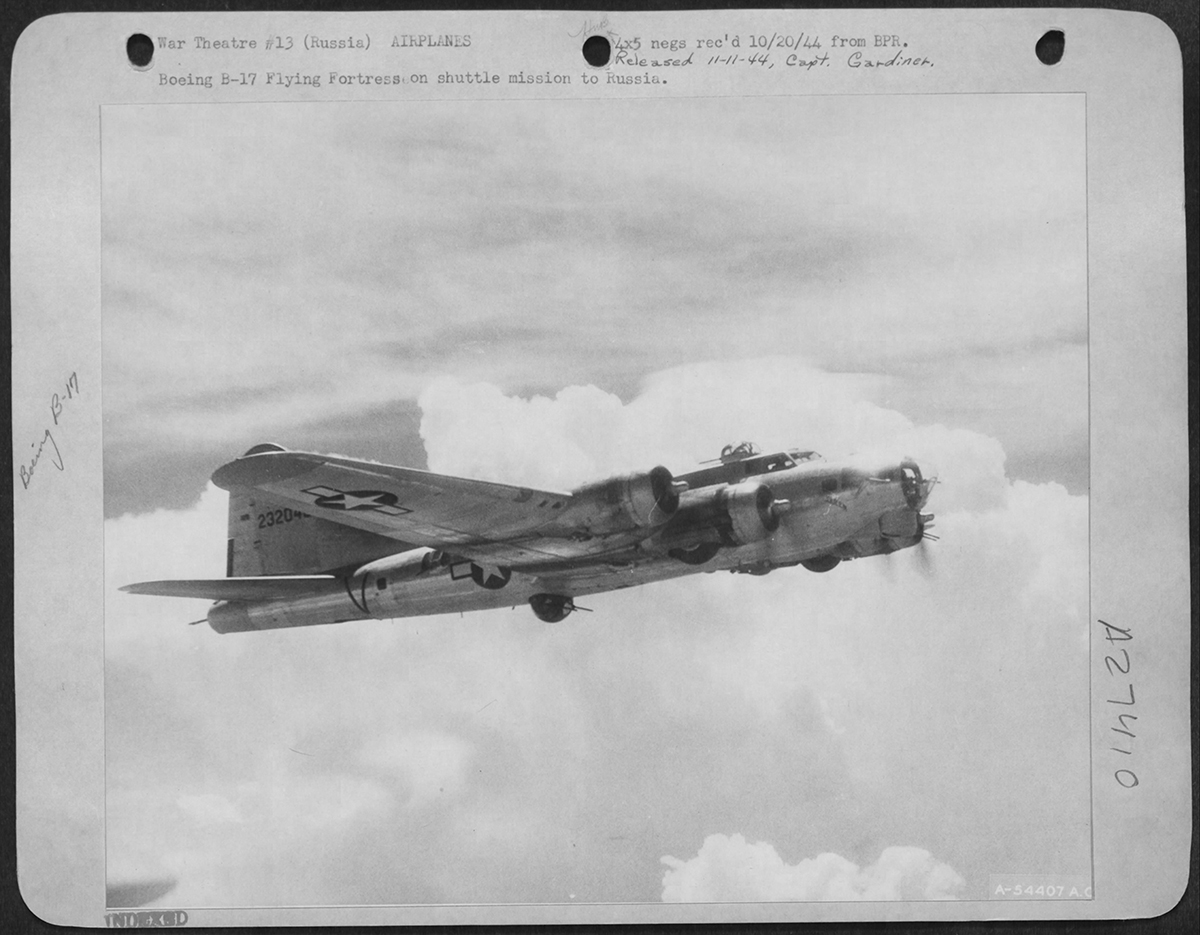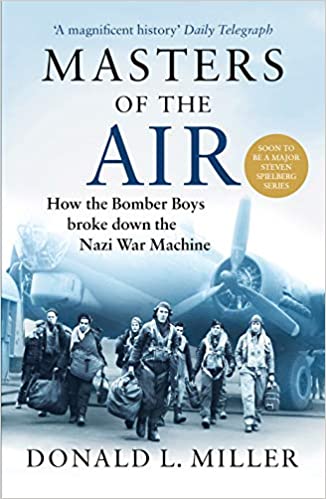 zoom_in
zoom_in
Quelle:
www.fold3.com
Produktionsblock:
B-17G-35-BO: 42-31932 bis 42-32116
Hersteller:
Boeing
- Bomber-Gruppe:
- 2nd Bomb Group
- 483rd Bomb Group
- 96th Bomb Group
- Bomber-Staffel:
- 20th Bomb Squadron
- 840th Bomb Squadron
MACR: 8098
Geschichte der
B-17 42-32048 / Queen
Delivered Cheyenne 17/1/44; Billings 20/1/44; Amarillo 4/2/44; MacDill 4/2/44; Morrison 9/3/44; slated 96BG, but Assigned 840BS/483BG Tortorella 14/3/44; transferred 20BS/2BG Amendola 31/3/44; Missing in Action Moravska Ostrova, Czech. 2/8/44 with Jim Weiler, Navigator: Bob Embry, Bombardier: Frank Sulkey, Flight engineer/top turret gunner: Lonnie Bumgardner, Radio Operator: John Martin, Ball turret gunner: Ernie Wagoner, Waist gunner: John Adair, Waist gunner: Loren Byam,Tail gunner: George Dalcanale (9 Killed in Action); (cp-Irving Thompson (POW – recorded as wia in hospital, but no further details); enemy aircraft, crashed Wiseham; Missing Air Crew Report 8098. QUEEN.
Zuletzt aktualisiert: 9. Mai 2018
B-17 42-32048 / Queen Details
Boeing B-17G-35-BO “Flying Fortress”, S/N 42-32048, nicknamed “Queen” crashed close to a small village of Krhov, near Bojkovice. On August 29, 1944 it flew on the Dog 4 position. Its crew, however, did not fly in the composition in which they underwent training in the US. Into the original crew did not belong the co-pilot F / O Thompson, who started the tour on June 25, 1944 over Sete in France and finished twenty-three missions, as well as navigator 2/Lt. Embry, whose tour began on August 20, 1944 over Auschwitz and on that fateful day, he was on his sixth mission, S/Sgt. Byam, who flew his first mission over Blechhammer on August 7, 1944 and completed eight missions and Sgt. Adair who completed three missions with his first one on August 22, 1944 over Odertal. Radiooperator S/Sgt. John J. Martin has completed twenty-eight missions; his tour began on May 27, 1944 over St. Etienne and became the most experienced member of the crew.
Other pilots began their tour on July 5, 1944 by the mission over Montpelier, France. On Aug 29, 1944 2/Lt. Weiler started on his 13th mission, 2/Lt. Sulkey on 20th mission, T / Sgt. Bumgardner on 16th mission and S / Sgt. Wagoner and S / Sgt. Dalcanale on 15th mission.
Sudden and aggressive attack of the German fighters had for the airplane and its crew tragic consequences. One can only assume that there was a fire aboard of the stricken plane followed by the explosion. Although the crew certainly tried to leave the aircraft as fast as possible (those who had not been killed or seriously wounded), only four of them managed to bail out prior to explosion. But parachutes of three airmen, apparently soaked with gasoline, caught fire immediately after the explosion and they were killed by the free fall to the ground.
That day residents of Pitín and its neighborhood watched the usualy stream of American planes heading to north and suddenly they saw several machines burning. From the airplane that flew close to them, one flyer bailed out and was slowly descending on his parachute to the ground. German fighter was still shooting at him while he was falling down hanging under his chute… Shortly thereafter, the aircraft exploded and crashed southwest of Krhov. In the afternoon, German troops arrived to the crash site, inspected the wreckage of the machine and collected six mutilated bodies. In the afternoon the German pilot who shot „Queen“ down arrived to the crash site. After the battle he landed at the airport either in Kunovice or in Otrokovice, toke the motorbike and drove away to see „his“ B-17. On the way he stopped in Bojkovice where he toke the local photographer and and continued to Krhov. At the crash site he ordered the fotographer to take the set of pictures of him over the wreckage, see bellow.
The only survivor of the american crew was the co-pilot F/O Irving Delmar Thompson (b. December 11, 1920). He landed on a wooded hillside of the valley at Krhov and stayed hanging on a parachute on a tree. There he was discovered by German soldiers guarding the nearby border who helped him get on the ground. Because of severe contusions of his right leg he could not move, they transported him on a motorbike with a sidecar through Bojkovice and Pitín to Slavičín. Due to the flat tyre they had to stop in Pitín to fix it. Local people tried to speak to Thompson but Germans didn´t allow to do so. After the repair they arrived to the German garissons in Slavicin. On August 30, 1944 Thompson and other airmen were transported from the garisson to the Brno hospital with an expected period of four weeks of treatment. Along with him there were also hospitalized Robert McCloskey, Francis Flynn, William Tune and Harold Helveston, all from another crews. From November 6, 1944, his name appears in the records of the interrogation center at Oberursel, Germany and a POW camp Stalag Luft I in Barth became his final destination till the end of the war.
Germans identified only three of the crewmembers – the flight engineer T/Sgt. Bumgardner, the ball turret gunner S/Sgt. Wagoner and the left waist gunner S/Sgt. Byam. Those were very probably the airmen who managed to bail out before the impact. Six other airmen the Germans were not able to identify. Their by the explosions and fire mutilated bodies were transported to the morque at Slavičín. There they were, along with other 19 airmen from another crash sites, buried into the mass grave on August 31, 1944. Several days later, during the removal of the wreckage, an identification card with photo and name 2 / Lt. Robert L. Embry Jr was found at the crash site…
On the afternoon after the battle Mr. Antonín Kašparec arrived to the crash site. He worked as a forced worker in the ammunition factory in Bojkovice. Among the damaged parts of the downed bomber he found a silver bracelet that had on its outer side engraved a name „James A. Weiler“ and and „Oct 1-1943, A-757348, C A“ on the inner side. He carefully hid the bracelet and after the war, in September 1945, attempted to contact the airman’s relatives through the US embassy in Prague in a hope to return the bracelet to the family. Although he received from the embassy a response with instructions as how to proceed he postponed his activities because of the language barrier. In 1965, a friend of Antonin Kašparec travelled to Canada. Antonin gave him a bracelet with a letter for the airman‘s family and asked him to arrange its shipment through the US consulate in Canada. In Canada, a friend of Mr. Kašparec asked for help Mr. Jožka Špelina, who worked for the International Civil Aviation Organization in Montreal. Mr. Špelina managed to get in touch with flyer’s family and hand over the bracelet and letter. From the following correspondence with airman‘s mother Nora Weiler and his brother Joseph N. Weiler, who were very pleased by this contact, it was explained that James A. Weiler (b. December 30, 1921) got the bracelet from his parents after finishing his pilot‘s training and recieving the Wings.
Between September 3 to 5, 1946 American soldiers exhumed the buried airmen. After the identification (where it was possible) they were buried in France and Belgium,and many of them were later transferred to the US. James Weiler, Frank Sulkey, Lonnie Bumgardner and George Dalcanale are now buried at Jefferson Barracks National Cemetery in St. Louis, Missouri, section 84, grave 326 to 328, John Adair rests in Ft. Sam Houston National Cemetery, San Antonio, Texas, section S, grave 133 and John Martin was laid to rest after the cremation into the family grave at Malton Cemetery, New York in 1951. The other three airmen rest at the Lorraine American Cemetery, St. Avold in France; Robert Embry at the plot D, row 34, grave 35, Loren Byam at the plot A, row 12, grave 50 and Ernest Wagoner at the plot E, row 44, grave 29.
Shortly after the war, people of Krhov erected a wooden cross at the crash site with a table containing the names of nine fallen airmen. Many years later, in 1994, at the occasion of the 50th anniversary of the battle, a new monument was unveiled at the same place.
Source: Vzpomínky na neznámé letce, Jan Mahr, ISBN 978-903030-6-5 @ http://www.leteckabitvakarpaty.cz/sestrelena-letadla/usaf/letadlo4/






Kommentar schreiben